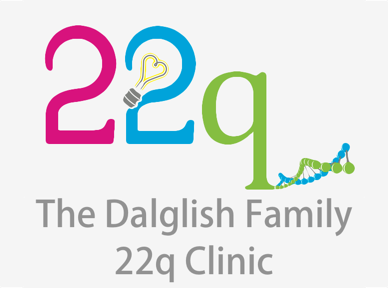How is genetic testing for 22q11.2 deletions done?
Recommended testing method
Chromosomal microarray analysis (CMA; also known as genomic SNP microarray or array comparative genomic hybridization (aCGH)) is the preferred initial clinical genetic test for suspected 22q11.2 deletion syndrome in a family.
This lab technique can show:
- the size of the 22q deletion;
- whether there are any other clinically relevant copy number changes (deletions or duplications) elsewhere in the genome; and
- other chromosome disorders that have similar phenotypes (health issues) as 22q11.2DS
It is recommended that patients and families receive genetic counselling both before and after undergoing any genetic tests.
Chromosomal microarray analysis (CMA)
This method is also known as genomic SNP microarray or array comparative genomic hybridization (aCGH). It is currently the preferred initial test for 22q11.2DS and is used at the Lab & Testing Services at the Hospital for Sick Children, Toronto. (They use the term “genomic SNP microarray”).
- Aim: to detect copy number variations in any part of the genome
- Process: Standard blood sample from the individual being tested is sent to a clinical lab
- Advantages:
- High resolution compared to older methods of analysis
- Detects typical and smaller or atypical 22q11.2 deletions and reveals the size of the deletion
- Screens the whole genome at the same time
- Fast and high throughput
- Detects both gains and losses in copy numbers resulted from a variety of causes (e.g. deletions, amplifications, loss of heterozygosity) elsewhere in the genome
- Detects other chromosome disorders that have similar phenotypes (health issues) as 22q11.2DS
- Disadvantages:
- Cannot detect chromosomal changes that do not result in changes in copy number, e.g. balanced translocations, inversions
To learn more, please have a look at the Chromosomal Microarray Testing video from MyHealth.Alberta.ca.
Whole genome sequencing
Whole genome sequencing (or simply genome sequencing) has been recommended as a diagnostic test in children with unexplained medical complexity. This method would be able to diagnose patients with uncommon variants (in 22q or other parts of the genome) which could otherwise be missed. It would also allow us to better understand the medical complexity of patients with 22q11.2 deletions.
-
Aim: to detect any genetic changes in any part of the genome
-
Process: Standard blood sample from the individual being tested is sent to a clinical lab.
-
Advantages:
-
Highest resolution compared to other methods of analysis
-
Improved coverage of exonic regions as well as comprehensive detection of all sequence and structural variation in the nuclear and mitochondrial DNA
-
Detects typical 22q11.2 deletions as well as the ones that other methods would miss
-
Screens the whole genome at the same time
-
Reduces the time and emotional burden of the diagnostic process
- Detects both gains and losses in copy numbers resulted from a variety of causes (e.g. deletions, amplifications, loss of heterozygosity, uniparental disomy)
-
-
Disadvantages:
-
Expensive (but the cost is becoming more manageable as time goes on)
-
Large amount of data to be processed
-
May be mistaken as a solution for all disease
- The classification of some genetic variants may change over time as new information becomes available. Some ethnic groups are under-represented in reference databases, making it more difficult to interpret certain variants.
-
To learn more, please have a look at:
- Genome sequencing as a diagnostic test (Costain et al., 2022)
- Genome Sequencing as a Diagnostic Test in Children With Unexplained Medical Complexity (Costain et al., 2020) with Commentary in SickKids news
Fluorescence in situ hybridization (FISH): targetted testing
- Aim: to check whether a specific section on one chromosome contains deletions, duplications, or translocations
- Process: Standard blood sample from the individual being tested is sent to a clinical lab
- Advantages:
- Technically reasonably straightforward
- Can identify a range of chromosomal aberrations including deletions, duplications, and translocations
- Disadvantages:
- Labour intensive, so fastest turnaround time possible is 3 to 14 days
- Cannot detect even large deletions if the binding site for the probe used is not in the actual deletion region
- Cannot provide information on the length or exact position of a deletion
- FISH test specific for typical 22q11.2 deletions:
- Two probes are used to bind to chromosome 22:
- TUPLE1 or N25 (here labelled with a red dye) binds to 22q11.2 (area of potential deletion)
- ARSA (here labelled with a green dye) binds to 22q13.3 (area on the far end of chromosome 22; not deleted in 22q11.2DS
- A normal chromosome 22 is not missing any parts, so both the red and the green probes can bind to their respective locations.
- A chromosome 22 with a 22q11.2 deletion has the green probe bind to the 22q13.3 location, but has nowhere for the red 22q11.2 probe to bind.
- Two probes are used to bind to chromosome 22:
| TUPLE or N25 (red) signal | ARSA (green) signal | |
|---|---|---|
| Normal chromosome 22 | Yes | Yes |
| Chromosome 22 with 22q11.2 deletion | No | Yes |
For sample results of this technique, please see this set of images.
Note: A negative FISH result can mean:
- The individual tested has no deletion at 22q11.2, but may have a genetic change somewhere else in the genome. e.g. 10p13-14
- The individual tested has a deletion at 22q11.2, but it is not within binding site of the TUPLE or N25 probe and therefore not detectable using these probes. This is estimated to happen about 8% of the time.
Because of FISH’s limitations, the preferred initial test for 22q11.2DS is Chromosomal microarray analysis (CMA). FISH may still be used for follow-up testing in other family members of individuals with a confirmed 22q11.2 deletion.
